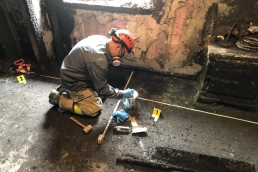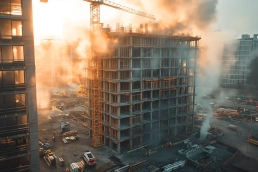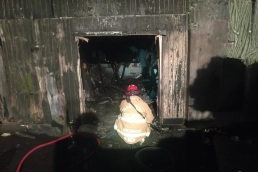Key Insights on Construction Fire Safety

With more than 20 years of experience in fire investigation, prevention and consultation, John Heinen, principal fire investigator at Compass Fire Investigations and Consulting, is well versed in understanding the safety risks on temporary construction sites.
As National Fire Protection Association (NFPA) figures remind us of the staggering $408m cost of fire-related damage on site, as well as the associated insurance payout, John discusses the changes that can be implemented by Authorities Having Jurisdiction (AHJ), as well as contractors, to ensure a safer and more secure environment for construction and fire workers.
Q: Tell us more about your role and experience in fire investigation to date?
I have been a certified fire investigator for more than two decades. I started my career as a volunteer firefighter, before moving into a full-time firefighter role. After graduation from recruit school, I was introduced to services within the fire marshal office, which ignited a passion for fire prevention, plan review, code inspections, education, and investigation.
For the past six years, I have been involved in private fire investigations, opening up my own company that specializes in not only fire forensics (origin and cause investigations), but also fire code consulting, compliance monitoring, safety and insurance loss prevention surveys, and teaching/instruction. Prior to opening my own company, I was recruited by a forensic engineering firm where I created and directed a nationwide business line for fire investigations and oversaw approximately 135 fire investigators, managing losses from coast to coast, from small fires to very complex losses.
After so many years in the industry, I have an extensive background in fire investigations that covers not only residential structures, but also large complex commercial/industrial investigations and construction site fires. My experience has given me a deep understanding of fire and building codes, and I am an active member of the National Fire Protection Association (NFPA), helping the organisation drive forward codes and standards development. I have worked on numerous construction site fires and have a robust understanding of NFPA 241, IFC Chapter 33, and other applicable codes and standards.

We are at a major crossroads for our fire prevention efforts. I am excited about the technology and the resources that are available to not only identify the problems that we are experiencing, but also the minds that are coming up with the solutions to these problems and helping to drive the industry towards more success.
John Heinen - Fire Investigator

Q: What do you see as some of the biggest fire risks on temporary construction sites?
There is no standard method of detecting a fire emergency on construction sites. This, along with the delays between the discovery of a fire and reporting to the fire department, means the results are often deadly. This can be explained by the fact that construction workers are used to working around an unstable and dynamic environment, which has a higher level of danger associated than the average office job.
As a result, the individuals involved in construction are more prone to go and investigate the source of the initial problem and then attempt to mitigate it themselves through the use of portable fire extinguishers or alternative methods. This only adds to delays, as it takes time for individuals to notice smoke or other early signs of a fire emergency, and determine it as a problem and not simply hot works, or a piece of heavy equipment starting up for example.
On top of this, plans and preparation for an organized evacuation of a site is a real problem for most contractors and was one of the major issues with the tragedy in Charlotte, which resulted in the death of two construction workers. Many sites are under prepared when it comes to fire prevention, fire alarm initiation or detection devices and procedures, as well as alerting fire departments to help save lives and site assets.
How can wireless technology help to progress the fire safety sector in North America?
It is imperative that we get behind and understand the benefits and minimal limitations to wireless technology. Specifically on construction sites, we are not in a position to have a full wired system during the construction phase, specifically as these are sites in the temporary phase, without full power access and supply. Wireless systems are primed to be able to address the current problem. Many of these technologies, like those offered by firms such as Ramtech, are portable, and come with long battery lifespans. However, it can often be a simple attitude shift that is needed.
As an industry, it has become normalised that constructed buildings have designated building methods and materials, a required amount of protected exits, a fully monitored fire alarm system, sprinkler system, and other safety measures, prior to receiving the certificate of occupancy. However, the very same building during the construction phase has many less requirements and in actual practice has very few of those controls in place. In using a wireless system, such as the WES3, many of the problems regarding speed responsiveness and human error are nullified, given it can act as a 24/7 smoke and heat detection system, with mobile alert integration for fire program managers.
Q: How have some of your experiences shaped the way you now investigate sites?
Throughout my career, I’ve been able to gain knowledge in the full life cycle of a fire emergency, from code and standard development to education, inspection, enforcement, emergency response, investigation and failure analysis. With incidents, I am able to see the bigger picture, rather than just dealing with it in isolation, which in turn helps prevent future fire instances and identify patterns or trends that are emerging.
While each investigation is unique, having that 360-degree viewpoint of fire science, fire dynamics, and fire behavior – coupled with an understanding of human practices and construction site dynamics – has proved to be invaluable. The ability to go beyond and extract the results and help to change the way we view new standards and codes is one of the most critical pieces of the life cycle.

Q: Are there any examples of great fire prevention methods you have seen, and vice versa, areas you’d like to see improved?
Some of the characteristics that I find to be common across the great fire prevention programs are:
An appropriate amount of portable fire extinguishers, call boxes, evacuation procedures as per the scale of the site.
Management that seeks out and encourages involvement of insurance, loss prevention, local building and fire code experts to help develop and approve the fire prevention plan.
A designated individual to manage the program that isn’t a superintendent or project manager – this can lead to inefficient programs, given these positions often have multiple site pressures and stresses i.e. timeline and delivery expectations.
Initiating devices throughout a project structure, added continuously as a project grows in size.
Fire sprinkler systems that are scaled with the construction program.
Growth potential common parameters that I have observed include:
Lack of a fire prevention plan or if there is one, it is not encompassing, not site specific, and simply put in a ‘checkbox’ style plan.
Absence of fire protection related equipment/controls, such as fire extinguishers, smoking controls and hot work protection.
Lack of management buy-in for general safety and fire prevention, coupled with a lack of internal enforcement or control by management.
What’s your overall consensus on fire safety in North America and where do you see its future?
We are at a major crossroads for our fire prevention efforts. I am excited about the technology and the resources that are available to not only identify the problems that we are experiencing, but also the minds that are coming up with the solutions to these problems and helping to drive the industry towards more success. The major issue for the construction industry is the perceived notion that in order for something to be done right, correct, and safely, that it is in direct opposition to doing something cost effective and speedy. Although contractors might need to spend a little more money to improve fire prevention efforts, it is nothing compared to the larger picture of these projects, which are often measured in years and tens of millions of dollars, alongside the huge cost associated with fire loss on site. That is simply a price for which one cannot be assigned to.